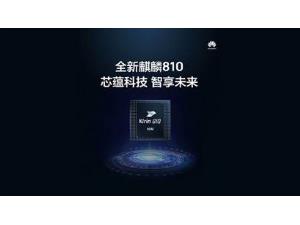



Date:24/06/19
 Huawei just announced its brand new Kirin 810 SoC - a mid-range chip based on the same 7nm manufacturing node as the flagship Kirin 980. It's also the only mid-range SoC with 7nm manufacturing process - Qualcomm's offerings do come close at 8nm, though.
Huawei just announced its brand new Kirin 810 SoC - a mid-range chip based on the same 7nm manufacturing node as the flagship Kirin 980. It's also the only mid-range SoC with 7nm manufacturing process - Qualcomm's offerings do come close at 8nm, though.
The SoC accommodates an octa-core CPU and a Mali-G52 MP6 GPU. The CPU consists of two high-performance ARM Cortex-A76 cores clocked at 2.27GHz and six smaller ARM Cortex-A55 cores ticking at 1.88GHz.
As far as the GPU is concerned, Huawei promises around 162% better performance over the last generation found in the Kirin 710.
Compared to its competitor, Qualcomm Snapdragon 730, the Kirin 810 promises 11% better single-core and 13% better multi-core performance. GPU-wise, the Mali-G52 MP6 should outperform the Adreno 618 in the SD730 with up to 44% higher frame rates.
The Kirin 810's hidden weapon is the DaVinci NPU based on the Rubik's Cube Quantitative Stereo Arithmetic Unit capable of outperforming the Snapdragon 855 and MediaTek Helio P90 in AI-related tasks.
The NPU has been put to work in other areas as well. It's supposed to help the GPU, CPU and memory communicate faster and run more efficiently to ensure stable performance for longer periods of time. The AI system can predict GPU overload and adjust frequency accordingly. It also tracks frame rates, fluency and touch screen input changes in real time.
Huawei is particularly proud of its flagship-grade IVP + ISP with upgraded pixel processing unit, improved white balance algorithm and noise reduction in RAW image processing. It should help the camera deliver more detailed low-light images.
The SoC will be powering the newly announced Huawei Nova 5 and it will eventually make it to other mid-tier Huawei and Honor smartphones.
Huawei unveils 7nm HiSilicon Kirin 810 chipset
 Huawei just announced its brand new Kirin 810 SoC - a mid-range chip based on the same 7nm manufacturing node as the flagship Kirin 980. It's also the only mid-range SoC with 7nm manufacturing process - Qualcomm's offerings do come close at 8nm, though.
Huawei just announced its brand new Kirin 810 SoC - a mid-range chip based on the same 7nm manufacturing node as the flagship Kirin 980. It's also the only mid-range SoC with 7nm manufacturing process - Qualcomm's offerings do come close at 8nm, though.The SoC accommodates an octa-core CPU and a Mali-G52 MP6 GPU. The CPU consists of two high-performance ARM Cortex-A76 cores clocked at 2.27GHz and six smaller ARM Cortex-A55 cores ticking at 1.88GHz.
As far as the GPU is concerned, Huawei promises around 162% better performance over the last generation found in the Kirin 710.
Compared to its competitor, Qualcomm Snapdragon 730, the Kirin 810 promises 11% better single-core and 13% better multi-core performance. GPU-wise, the Mali-G52 MP6 should outperform the Adreno 618 in the SD730 with up to 44% higher frame rates.
The Kirin 810's hidden weapon is the DaVinci NPU based on the Rubik's Cube Quantitative Stereo Arithmetic Unit capable of outperforming the Snapdragon 855 and MediaTek Helio P90 in AI-related tasks.
The NPU has been put to work in other areas as well. It's supposed to help the GPU, CPU and memory communicate faster and run more efficiently to ensure stable performance for longer periods of time. The AI system can predict GPU overload and adjust frequency accordingly. It also tracks frame rates, fluency and touch screen input changes in real time.
Huawei is particularly proud of its flagship-grade IVP + ISP with upgraded pixel processing unit, improved white balance algorithm and noise reduction in RAW image processing. It should help the camera deliver more detailed low-light images.
The SoC will be powering the newly announced Huawei Nova 5 and it will eventually make it to other mid-tier Huawei and Honor smartphones.
Views: 475
©ictnews.az. All rights reserved.Similar news
- Azerbaijani project to monitor disease via mobile phones
- Innovative educational system to be improved under presidential decree
- NTRC prolongs license of two TV and radio organizations for 6 years
- Azerbaijan establishes e-registry for medicines
- Azerbaijani museum introduces e-guide
- Nar Mobile opens “Nar Dunyasi” sales and service center in Siyazan city
- International conference on custom electronic services held in Baku
- OIC secretary general to attend COMSTECH meeting in Baku
- Azerbaijan develops earthquake warning system
- New law to regulate transition to digital broadcasting in Azerbaijan
- Azerbaijani State Social Protection Fund introduces electronic digital signature
- Intellectual traffic management system in Baku to be commissioned in December
- Tax Ministry of Azerbaijan started receiving video-addresses
- World Bank recommends Azerbaijan to speed up e-service introduction in real estate
- Azerbaijan to shift to electronic registration of real estate





















